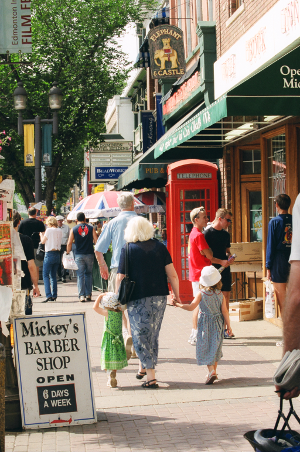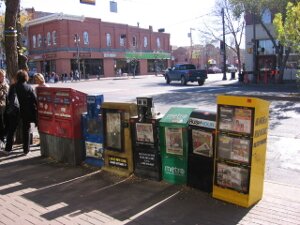Streetscape
 Sidewalks are used differently during the day than they are at night. Planters and benches that provide aesthetic beauty during the day, can turn into tripping hazards at night, impede pedestrian flow and block public access to sidewalk crossings.
Sidewalks are used differently during the day than they are at night. Planters and benches that provide aesthetic beauty during the day, can turn into tripping hazards at night, impede pedestrian flow and block public access to sidewalk crossings.
Growing support of, and demand for, walkable communities is impacting the ways that cities plan and manage sidewalks. Walkable, multi-use sidewalks in hospitality destinations will generally feature:
- access to popular destinations through efficient design of streets, walkways and sidewalks
- pedestrian safety and protection from automobile and bicycle traffic
- aesthetically pleasing surroundings, including clean and well-maintained streetscapes designed at a human-scale
- a variety of lively and sociable activities on sidewalks
- opportunities to work, live, play and socialize in the same area*
When planning and managing sidewalks it is important to consider how they will be used at all times of the day and night and in different seasons.
The sidewalks in mixed-use entertainment areas present a challenge in terms of balancing the features that make for an interesting social space while providing walkability.
For example, Whyte Avenue’s narrow sidewalks can impact ease of pedestrian flow during peak times. Conversely, Jasper Avenue has long stretches of sidewalk that lack popular destinations and services. To improve the experience patrons have while walking these multi-use sidewalks, the City of Edmonton is taking a “wide lens” view to address sidewalk concerns.
Benches
Edmonton’s Capital City Downtown Plan embraced the use of numerous styles of benches to create unique areas along Jasper Avenue with historical, artistic, modern and urban furniture.
Bench placement has presented some challenges relative to loitering and either directly impacting the clientele of an adjacent business or creating an unpleasant ambience on the street. Numerous benches have been removed, which is counterproductive to creation of a sociable city.
Discussions are ongoing to consider replacing benches with a seating unit that fits architecturally with the area, is highly durable, can be placed in ways that encourage conversation yet discourage lounging and sleeping, and don’t impede traffic flows during peak times such as late at night.
Bike Racks
Hospitality destinations attracts many cyclists. Due to high vehicle traffic and narrow sidewalks, both cycling and parking present challenges. Bicycle rack replacement in Edmonton started in 2008 and is ongoing. See www.edmonton.ca/bikeplan.
Extended Building Lobbies and Sidewalk Cafés
Extended building lobbies and sidewalk cafés are permitted through Transportation Right of Way. For more information please see www.edmonton.ca/bylaws_licences/licences_permits/road-rights-of-way.aspx.
 Newspaper Boxes
Newspaper Boxes
To prevent an overcrowding of newspaper boxes in high pedestrian neighbourhoods, the City of Edmonton, in conjunction with newspaper vendors, have developed guidelines for an equitable and street-appropriate number of boxes per designated site. This set of guidelines has eliminated spatial problems and has limited the number of boxes that are tipped over or vandalized late at night. U-bars have been installed on the sidewalk to delineate sites and provide increased security for the boxes.
Signs
On-street signage is restricted to sandwich boards of particular dimensions as outlined in a City bylaw. Placement and numbers can present challenges to comfortable pedestrian walkability.
Street Lighting
Alleys with high pedestrian traffic that serve as shortcuts to parking areas on the north and south sides of Whyte Avenue were identified and additional street lighting was installed. Street lights in key locations along Whyte Avenue have been enhanced from 75 to 150 watts, providing increased visibility. These lighting improvements resulted in a significant increase in both the perception of safety and actual safety in the area. Incidents of vandalism also decreased.
The ambient lighting of the decorative streetlights along Whyte and Jasper Avenue is operating at a compromised level due to the age of the fixtures. This is partially offset by the decorative lights on the boulevard trees. Options for improvements to both of these lighting situations are currently being investigated.
Telephone Booths
At several locations along Whyte and Jasper Avenues, telephone booths were determined by adjacent businesses or EPS to be sites that could attract drug dealers. To balance the need for late-night safety with a desire to reduce criminal behaviors, several phones have been changed to 911 only after 9pm. This appears to have been effective.
*Information courtesy of Responsible Hospitality Institute’s Planning, Managing and Policing Hospitality Zones – A Practical Guide



 Quick Links
Quick Links